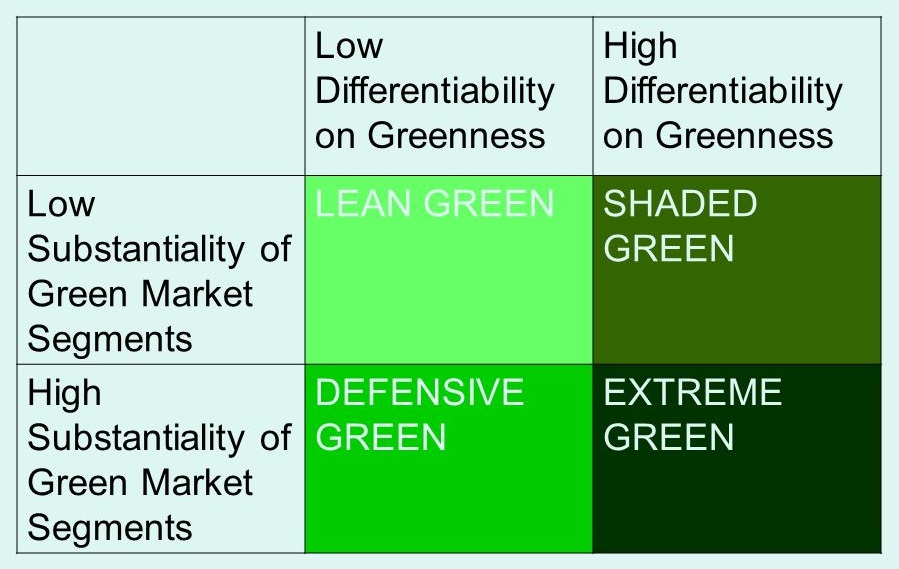Industry green norms and potential green market size are key issues for companies looking to gain competitive advantage with green marketing. Companies should consider the likely size of green markets in its industry as well as how can they differ their green products or services from their competitor’s one’s before they take steps on going green.
There are four types of green strategies: Lean Green, Defensive Green, Shaded Green and Extreme Green. Following Green Marketing Strategy Matrix illustrates the need for companies to identify their position in regards to substantiality of green market segments and differentiability of greenness in order to choose the right strategy to enter a green market.
Promotions tools adopted by this strategy are rather quiet such as public relations versus mass advertising. The Shaded Green strategy puts some secondary emphasis on greenness in its more overt promotional efforts and also pursues green product development as well. Extreme Green strategy involves heavy use of all four marketing mix elements, including place as distribution systems, massive advertising, retailers etc.
Differences among these four green strategies can be seen by considering how the 4Ps of the marketing mix are utilized in each strategy. The Lean Green strategy is the one who mainly focuses on product development, design and manufacturing. The Defensive Green strategy also pursues greenness in product section but additionally, it involves the promotional aspect of the marketing mix.
Green Strategy 1: Lean Green
Companies that choose lean green strategy indicate that they are low at both substantiality of green market segments and differentiability of greenness. Lean greens are interested in reducing costs and improving efficiencies at the same time through pro-environmental activities. Their initial competitive advantage would be a lower-cost advantage instead of green one. Because they are at a very low position in both dimensions, they are not focused on publicizing or marketing their green initiatives. Lean greens are not often motivated to promote their green activities or green product attributes because of the fear of being held up to a higher standard; and they are not always able to live up to it or differentiate themselves from competitors.
Coca Cola can be characterized as a lean green company. Most consumers are not aware that the company has invested heavily in various cycling activities and package modifications. Because the wide target market and brand breadth of the company, Coca Cola has chosen not to market its effort even though it is concerned about the environment.
Green Strategy 2: Defensive Green
Defensive green companies usually see green marketing as a precautionary measure, or as a response to a crisis or a response to a competitor’s actions. They seek to enhance brand image and mitigate damage. They recognize green marketing is important and profitable but they cannot afford to go green. Their environmental initiatives seem to be sincere, but their efforts to promote these initiatives are rather sporadic and temporary because they are not able to differentiate themselves from their competitors on greenness.
Defensive greens do not normally launch an overt and significant green campaign because aggressive promotions could be wasteful and would create expectations that cannot be met. They pursue actions such as small environmentally friendly events and programs.
An example would the Gap Inc. Gap has long promoted energy conservation and waste reduction. However Gap was criticized by environmental activists and press due to the involvement with an environmentally unfriendly company that was owned by Gap’s CEO’s relatives. Luckily, the company managed to weather the attack with a measured, quieter response through public relations.
Green Strategy 3: Shaded Green
Shaded green companies invest in long-term, system wide, environmentally friendly processes that require a financial and non-financial commitment. These companies see green marketing as an opportunity to develop innovative needs-satisfying products and technologies that result in a competitive advantage. Shaded green companies are well able to differentiate themselves from competitors on greenness but they chose to stress other attributes of the product with better financial returns possible. They primarily promote the direct, tangible benefits of the products and environmental benefits are only promoted as a secondary factor.
Toyota Prius can be characterized as shaded green. The brand is advertised as “an environmentally advanced, fuel efficient hybrid”. In fact, upon Launch in the US market the Prius’ environmental attributes were not stressed; the company focused on advertising fuel efficiency of the car.
Green Strategy 4: Extreme Green
Extreme green companies use a holistic approach with environmental green values shaping there philosophy. Environmental concerns are fully integrated in the business and product life-cycle processes. Extreme green companies pursue actions such as life-cycle pricing approaches, total-quality environmental management and manufacturing for the environment. Extreme companies often serve niche market and sell their products through boutique stores and specialty channels.
Honest Tea is one of the fast growing organic tea companies in the natural foods industry. Social responsibility is embedded in its identity and purpose from manufacturing to marketing its products.
